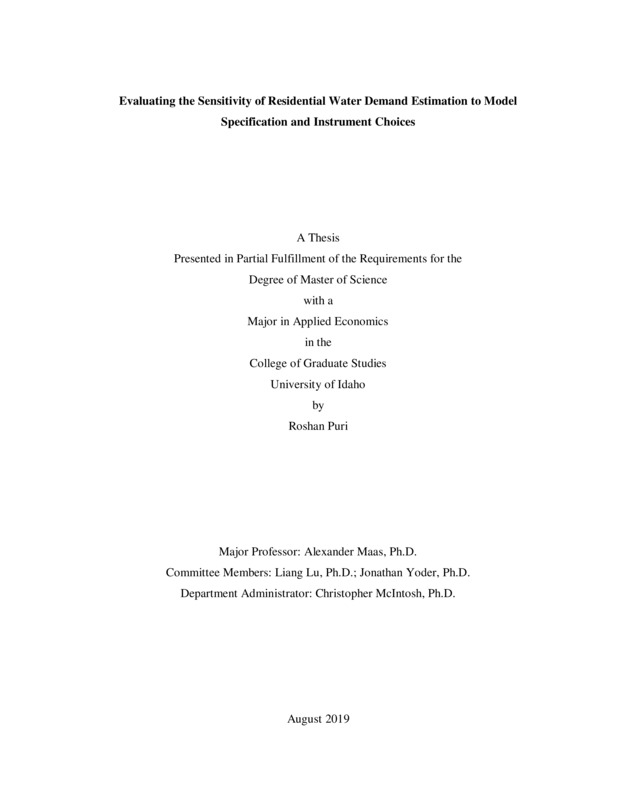Evaluating the Sensitivity of Residential Water Demand Estimation to Model Specification and Instrument Choices
Puri, Roshan. (2019-08). Evaluating the Sensitivity of Residential Water Demand Estimation to Model Specification and Instrument Choices. Theses and Dissertations Collection, University of Idaho Library Digital Collections. https://www.lib.uidaho.edu/digital/etd/items/puri_idaho_0089n_11658.html
- Title:
- Evaluating the Sensitivity of Residential Water Demand Estimation to Model Specification and Instrument Choices
- Author:
- Puri, Roshan
- ORCID:
- 0000-0001-8109-3234
- Date:
- 2019-08
- Keywords:
- Demand Estimation Price Instruments Residential water demand Sensitivity of water demand Weather Specification in water demand
- Program:
- Agricultural Economics and Rural Sociology (Applied Economics)
- Subject Category:
- Agriculture economics
- Abstract:
-
Past studies have estimated residential water with different econometric model choices. Inconsistency in the choice of the price signal, its instruments, and appropriate weather variables have offered qualitatively different estimates of price elasticity — both elastic (>1) and inelastic (<1) — in the water demand literature. This distinction is important, not only because elasticity estimates are critical in creating efficient and effective water conservation and management practices, but also because accurate demand responses to price changes help water utilities stabilize and anticipate future revenue. Therefore, an accurate estimate of price elasticity is necessary, which requires specifying the appropriate demand model. However, specifying residential water demand with an appropriate model (under increasing block rates) is challenging for three reasons: 1) little theoretical motivation exists for determining which weather variables affect demand, 2) there is an ongoing debate over the appropriate price signal on residential water bills, and 3) simultaneity issues in estimation require the use of instruments, which vary within the literature.
In this paper, we elucidate the effects of model choices on elasticity estimates by systematically varying the specification of price, instruments, and weather variables across a suite of models. Fixed Effects with Instrumental Variables (FE-IV) is employed in our model to control time-invariant effects and solve the problem of simultaneity, generating consistent and unbiased estimates of the coefficient. First, we conduct a formal Shin Test to investigate the price variables to which the households respond; after selecting the price signal, we fix the price variable and its instrument and re-specify the model across all possible combinations of weather variables (511 different combinations from the use of nine weather variables) to create a distribution of elasticity estimates. Lastly, we hold price signal and weather variables constant and run 31 separate model specifications using a suite of instrumental variables. Thus, this paper systematically evaluates how model choices influence elasticity estimates of residential demand estimation, providing insight into model choices and the validity of previous work.
As found in other work, our results suggest that average price rather than marginal price is the appropriate price signal to which households respond. For the choice of weather, we find 97% of our estimates between -0.83 to -0.57, which implies that choices in weather variables (average versus maximum daily temperature, for example) have little (or no) impact on elasticity estimates. Notable exceptions to this result are model specifications which only use precipitation variables (excluding temperature information). In these model specifications, elasticity estimates are qualitatively different (>1) and the model fit is worse. These results suggest that, so long as temperature variables are included, parsimonious models can provide consistent and efficient estimates, thereby reducing the need for more in-depth measurements (air pressure, humidity, wind speed, for instances) offered by advanced weather stations. Similarly, the choice of price instruments has a negligible impact on elasticity estimates (estimates clustered between -0.77 to -0.69), so long as the set of instruments are valid.
These results provide guidance to future researchers for if and how to include different weather metrics while modeling residential water demand. Further, these results also help stakeholders and water managers establish appropriate water price and pricing structure, thereby helping utilities stabilize and generate the revenue along with the proper demand-side management of water.
- Description:
- masters, M.S., Agricultural Economics and Rural Sociology (Applied Economics) -- University of Idaho - College of Graduate Studies, 2019-08
- Major Professor:
- Maas, Alexander
- Committee:
- Lu, Liang; Yoder, Jonathan
- Defense Date:
- 2019-08
- Identifier:
- Puri_idaho_0089N_11658
- Type:
- Text
- Format Original:
- Format:
- application/pdf
- Rights:
- In Copyright - Educational Use Permitted. For more information, please contact University of Idaho Library Special Collections and Archives Department at libspec@uidaho.edu.
- Standardized Rights:
- http://rightsstatements.org/vocab/InC-EDU/1.0/

